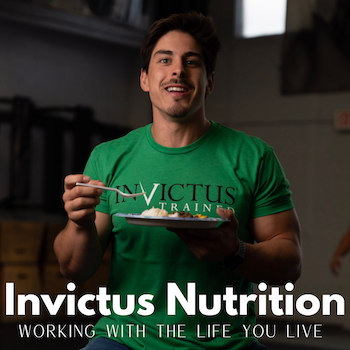
How to Adjust Caloric for While Injured
Written by Fritz Nugent
One of my nutrition clients – a busy professional, CrossFitter and scholar – recently sent me this email after retesting his body composition a few months into his new nutrition and lifestyle plan.
“The move-in went well, but the middle of my lower back to tailbone part got injured from a 5×4 back squat @ 175…I did the in-body test yesterday, and it seems like I’ve lost 0.8% of body fat which was fewer than I thought. I attached my two results. I confess!! I had dim sum after my inbody test on Saturday morning and sous vide rib-eye steak for dinner. Sunday after training, I dined out with my friend. I feel really guilty about my food and also feel bad about getting injured from the back squat.”
Here was my response…
First off, your InBody may be better than you thought. You lost 1.8lbs of pure body fat and are 2.2lbs lighter. You did this while maintaining your lean body mass, which is difficult to do. This is pretty close to recomposition, which is staying at the same weight while gaining or at least maintaining muscle while losing body fat.
How to Adjust Caloric Intake While Injured
Injuries happen…Here’s how to deal…
I’m sorry that you hurt yourself. Train the areas that aren’t hurt while you recover, and do what you need to do to heal up from your injury. You may need a deload week, or two. You were feeling good when you were training 1.5 hours a day. Now that you’re training 2 hours a day, you may not be eating enough, or training for that long each day might be too much with all that you have going on at work and with your studies. Your sleep + nutrition must be equal to or greater than your training stress + work stress + school stress for you to recover optimally!
Cheat Meals…
As for the dim sum and rib eye, that’s fine. Treating yourself to a nice meal once a week, sometimes twice, is ok. (Thoughts on cheat meals…) It’s part of a healthy balance. If you hold onto your diet too tightly, you are bound to go off – and in a big way. So instead, you are allowed to make guilt-free suboptimal eating choices sometimes. Read on below to understand how this fits with your calories!
Optimize Eating…
Overall, I think that you are consistently eating less than optimal. For example, this past week, you averaged 1600 calories/day Monday-Friday. Your BMR is 1436 calories. The BMR is the bare minimum that you need if you slept all day and ate no food. Once you get out of bed and use your brain (work and school) and use your body throughout the day, now your caloric daily need increases by 20-30% (300-400 more calories, now you’re up to needing 1736-1836 calories). And when you train for two hours, you need an extra 250-400 calories PER HOUR of exercise on top of that previous calorie total. So in a perfect world, I would have you eating 2000-2300 calories each day, minimum. When you undereat by a huge margin (400-700 calories a day), your body learns to make due with less food by limiting your energy expenditure. You may feel tired and unmotivated. Your training suffers. And injuries can occur from a buildup of inadequate recovery from training sessions over days or weeks, or even months.
The moral of the story…
If you want to continue training for strength while minimizing injury risk and maximizing your life outside of training, you have to eat more food. This also makes plenty of room for you eating out once a week with your friends. If you need to eat more calories, then having dim sum and a ribeye aren’t a problem, calorie wise. Your macros may be off a little, and that’s ok because the other 27 meals that week you were on your game.
Lastly, with how hard you train, I would expect more muscle mass gain from your training. Because your muscle mass did not increase, this is another marker that suggests you need to eat more food to support your training and life!
Think about all of this and let me know what you think.

Hello, I’m Fritz, the author of this post. This is a personal example of how I interact with my nutrition clients. Each client is different in their caloric and macro needs, and when you add in the complexity of unique habits and lifestyles, the solutions to situations can become very specific.
If you have any questions for me, let me know! Thanks for reading.